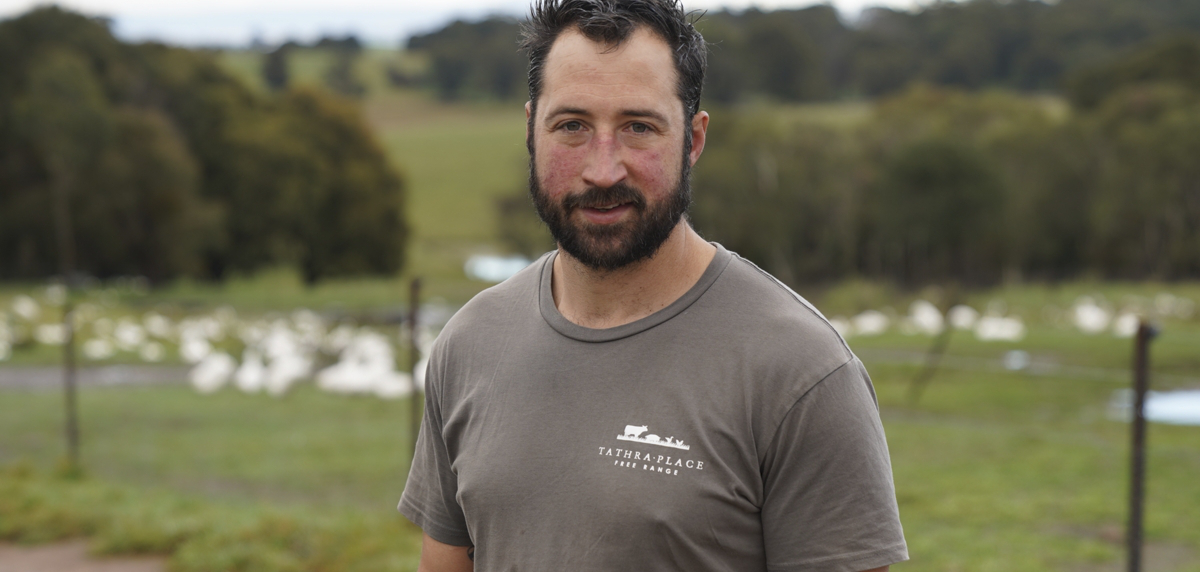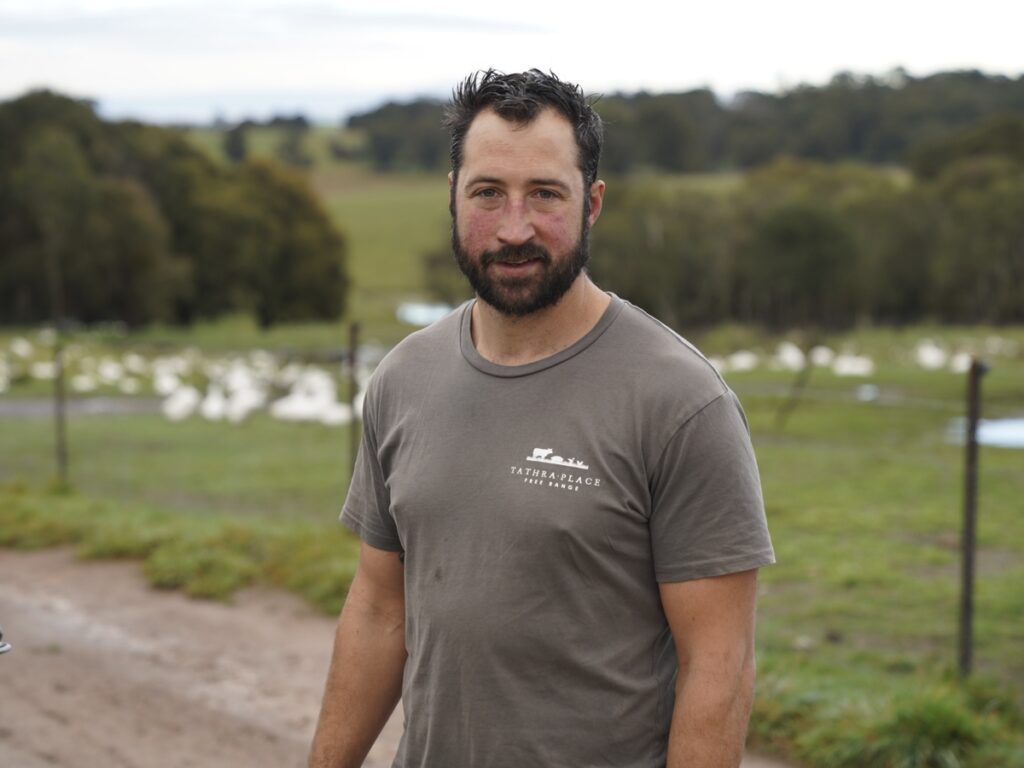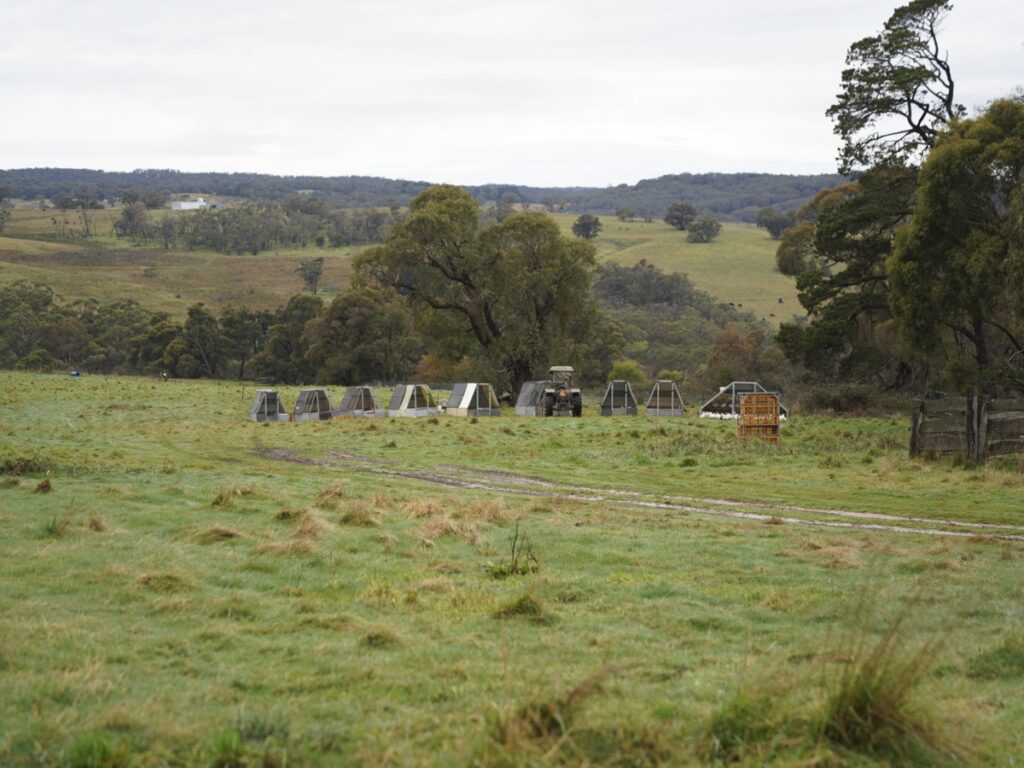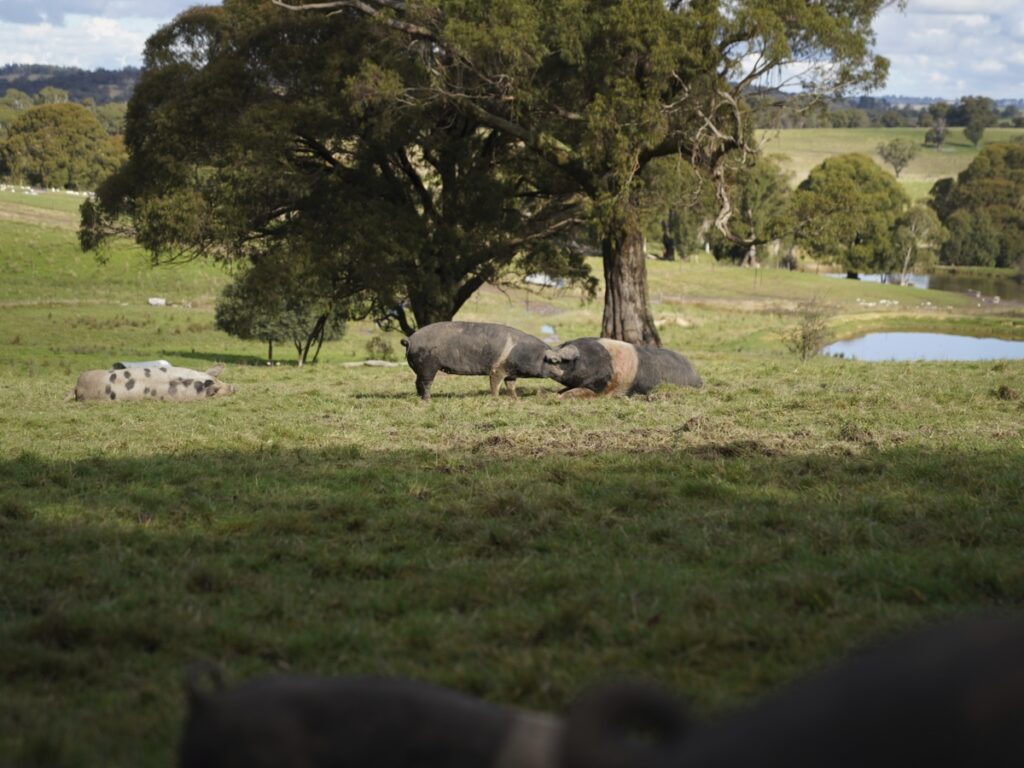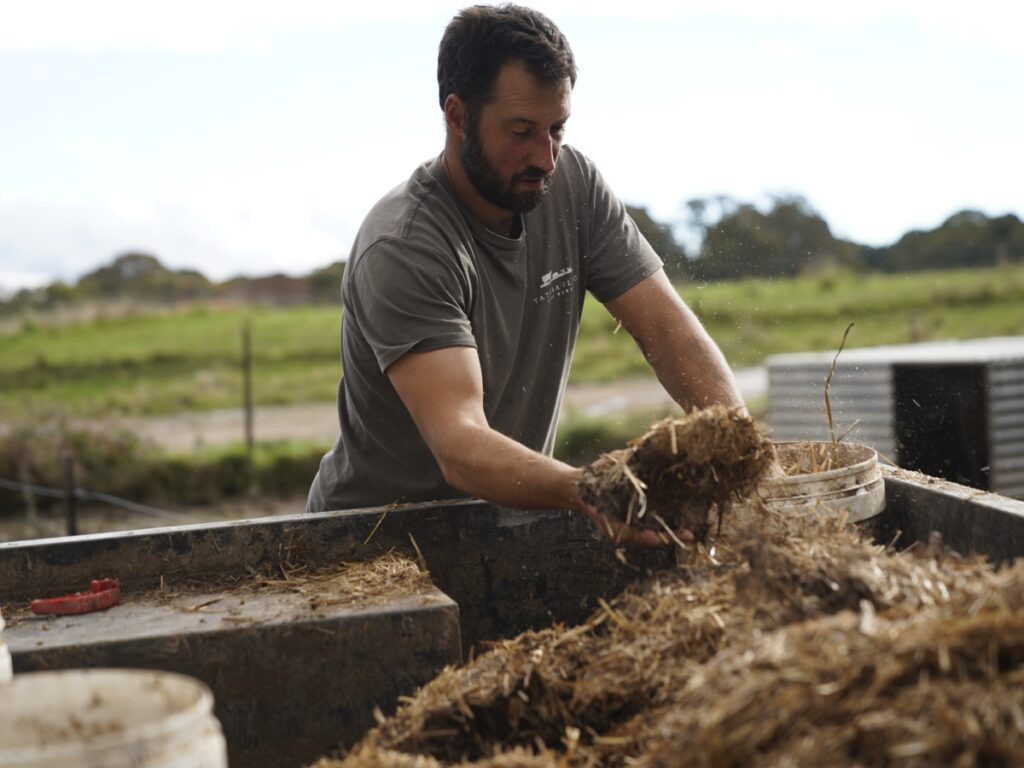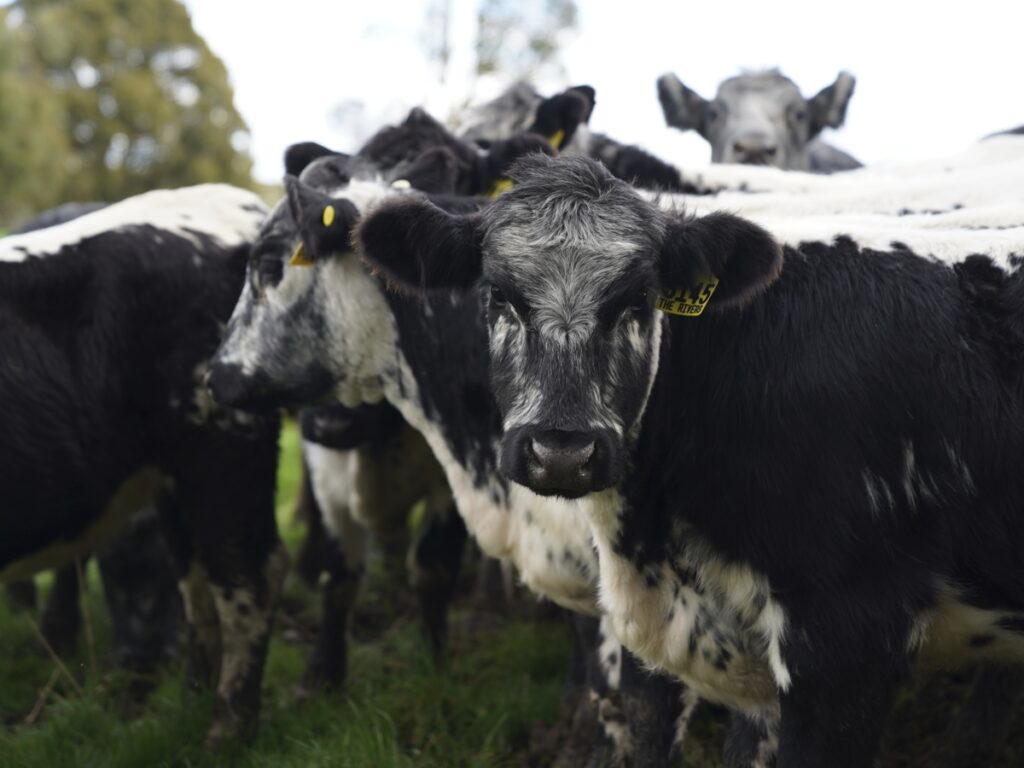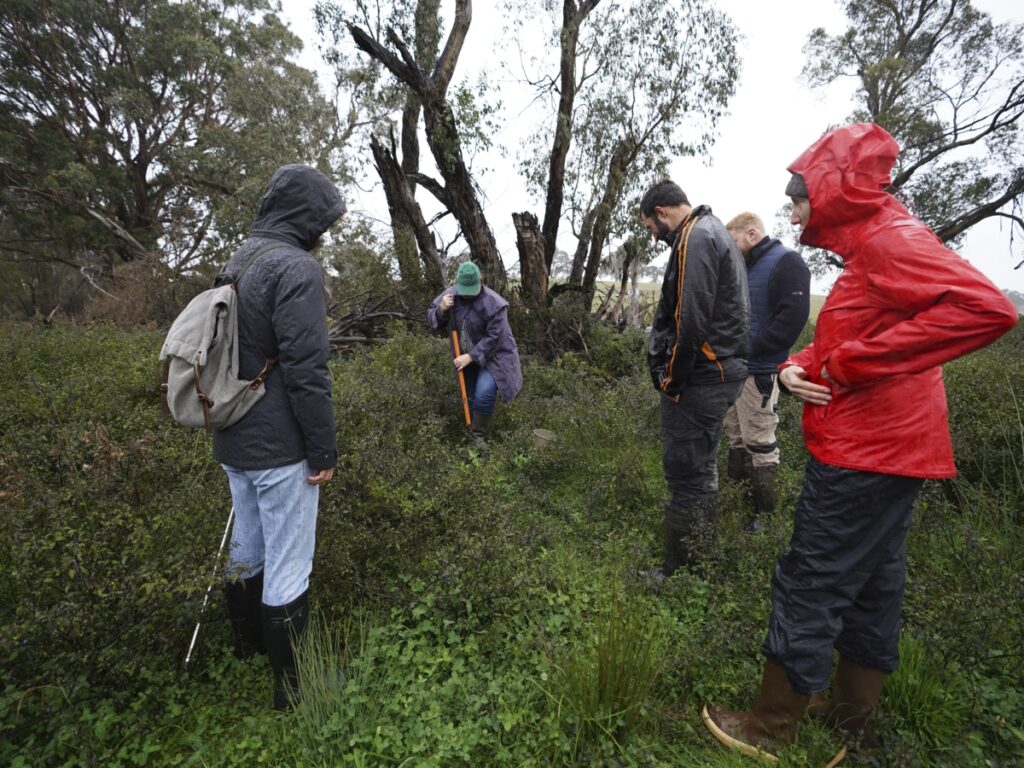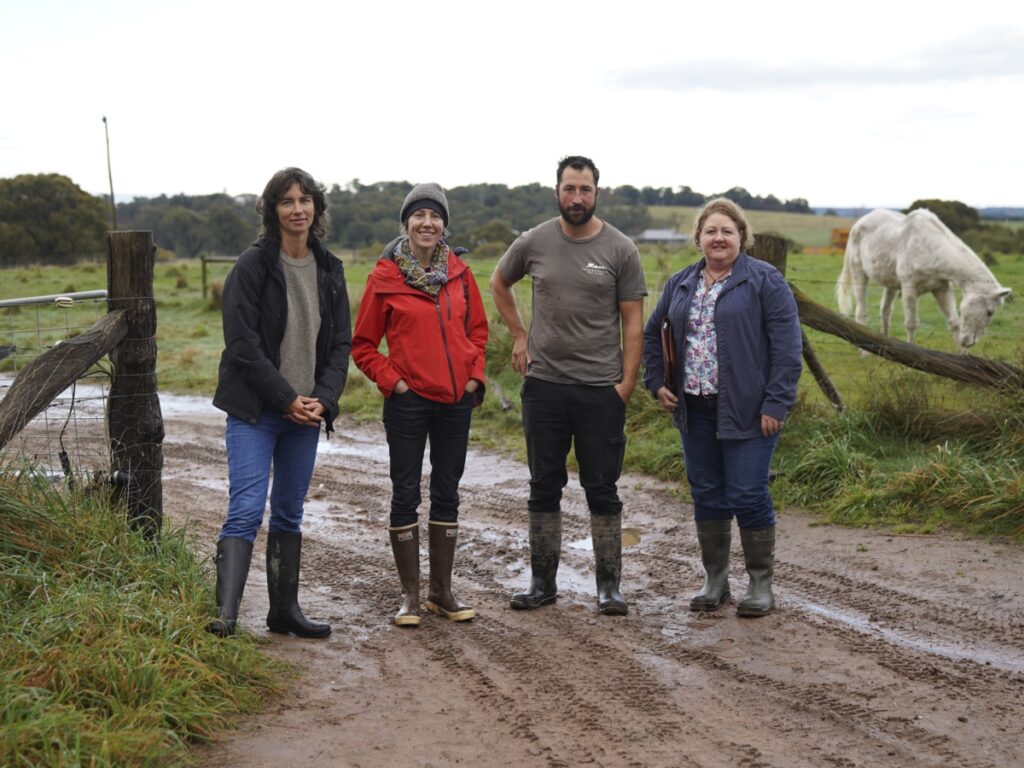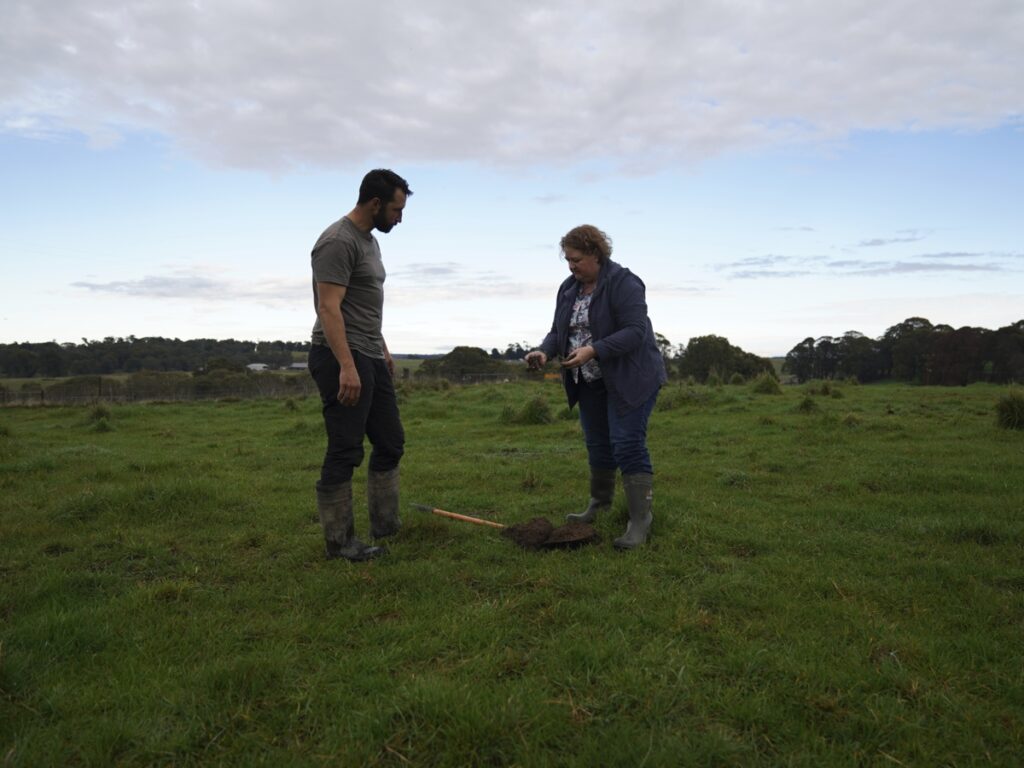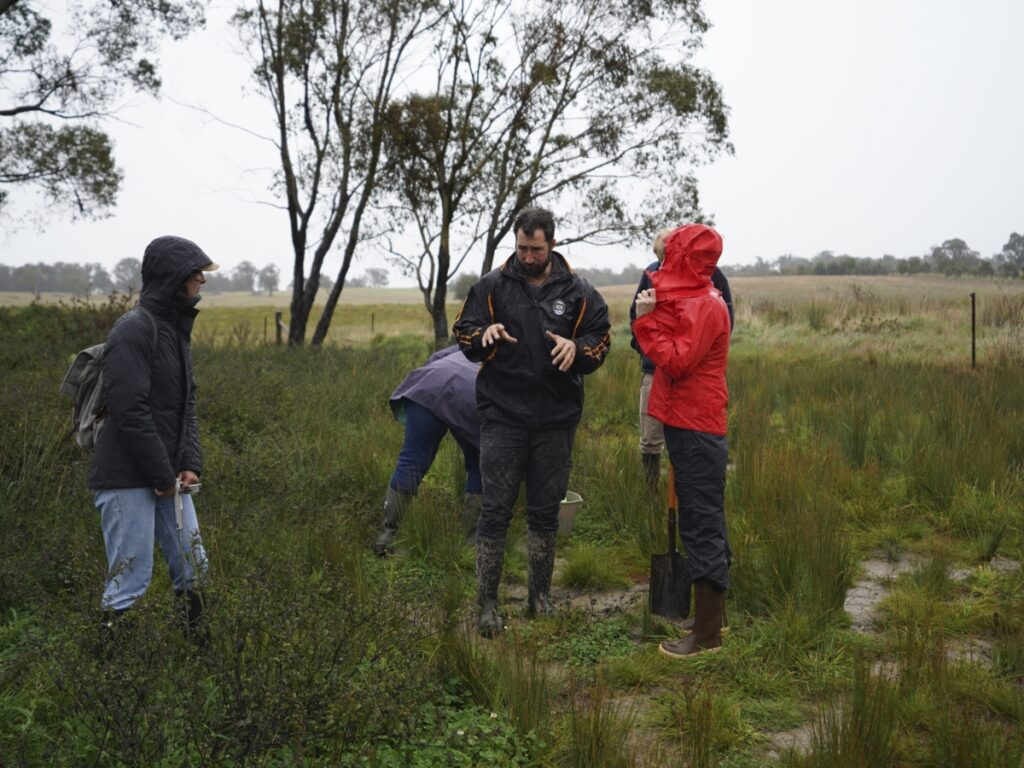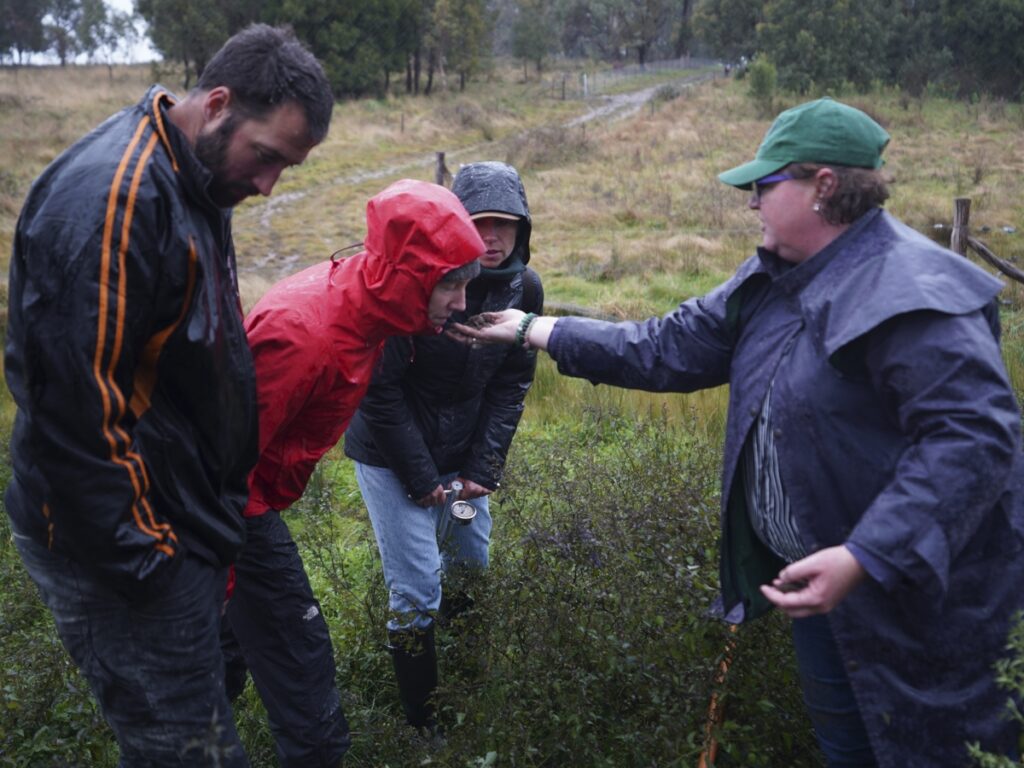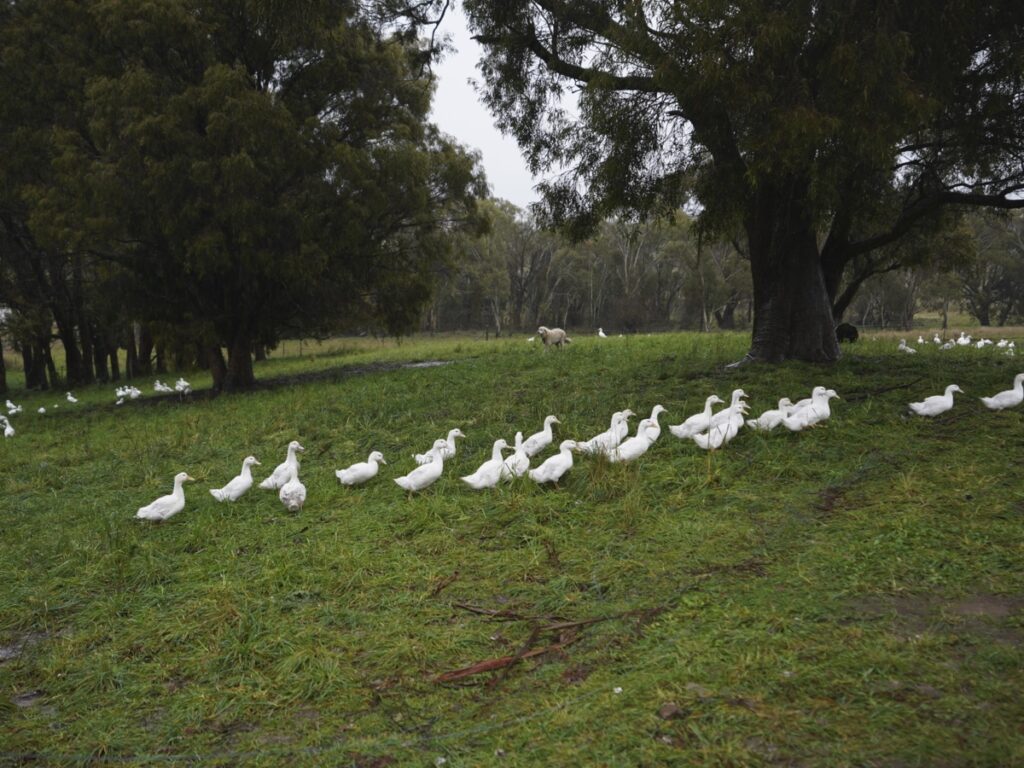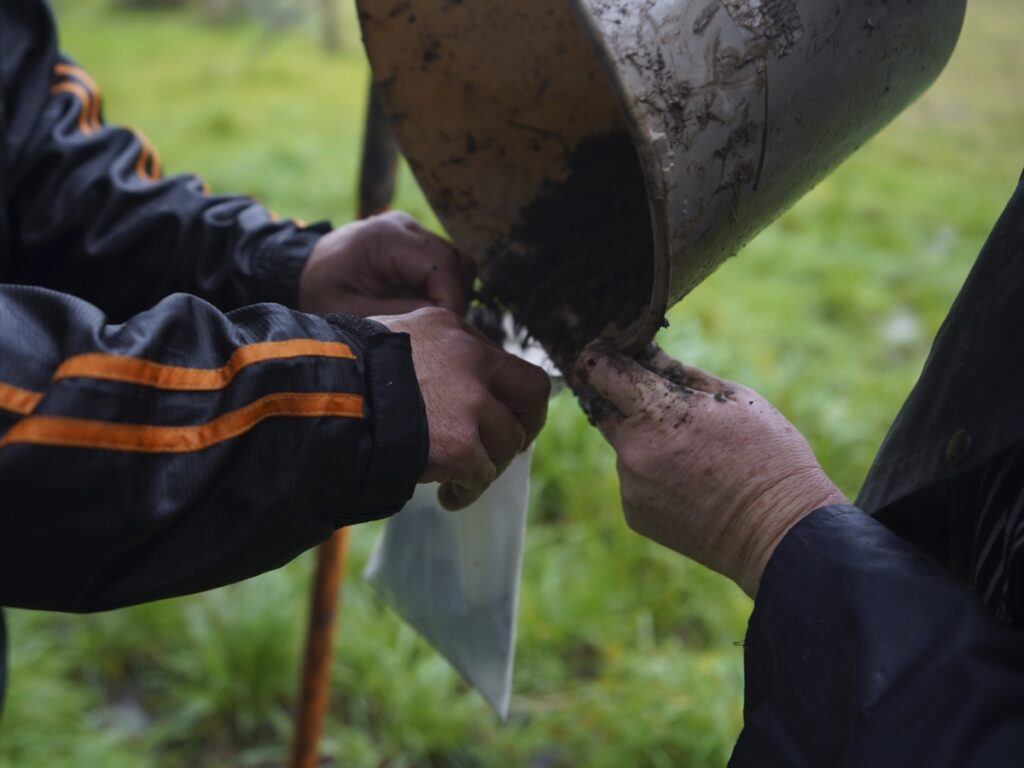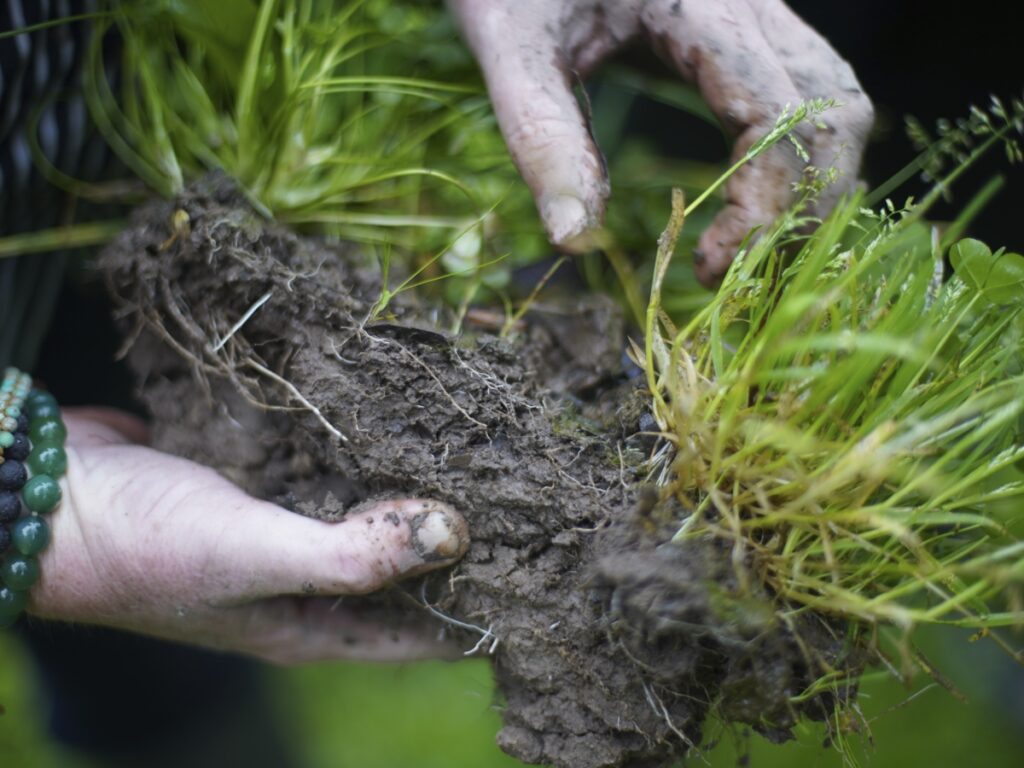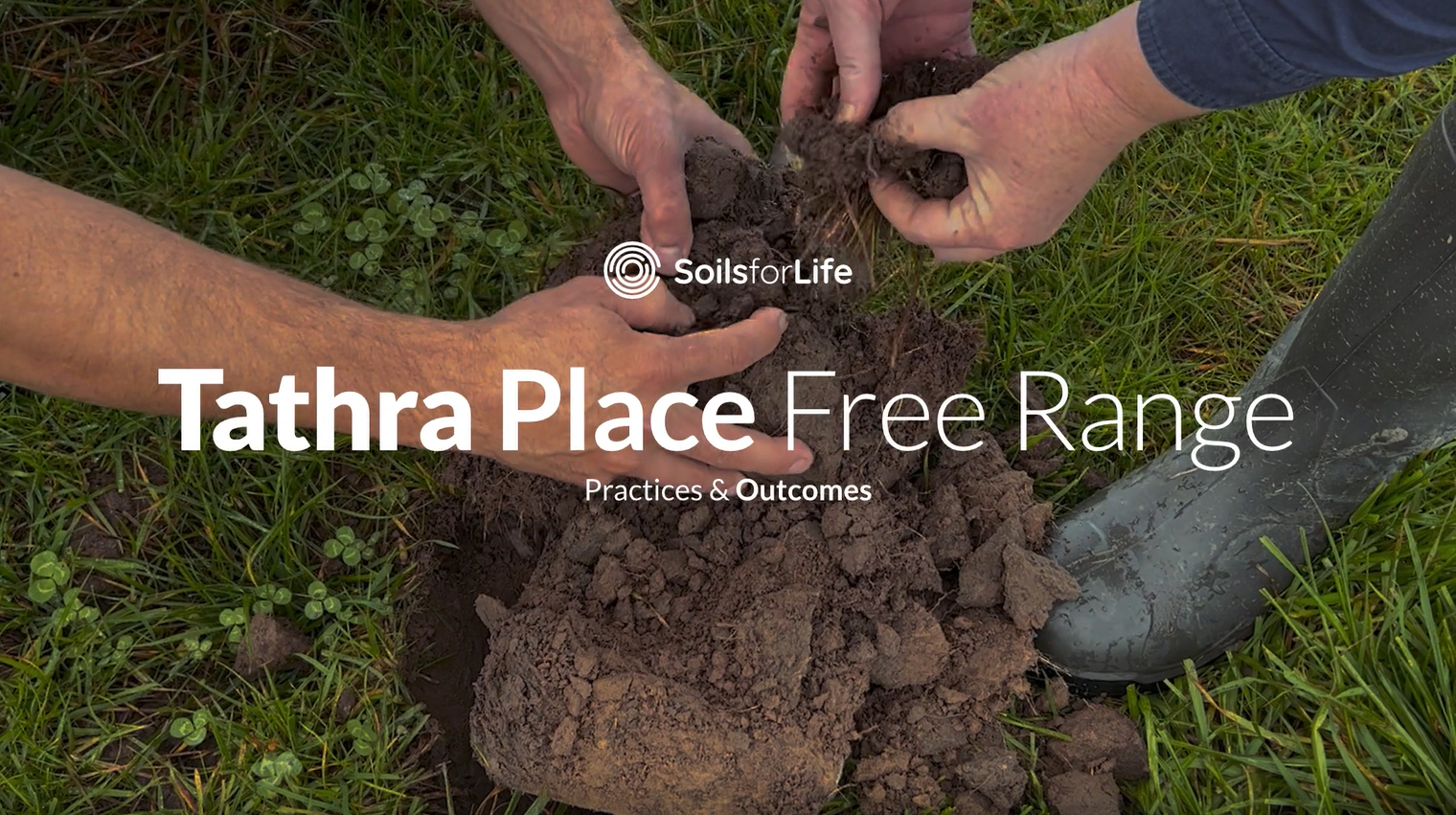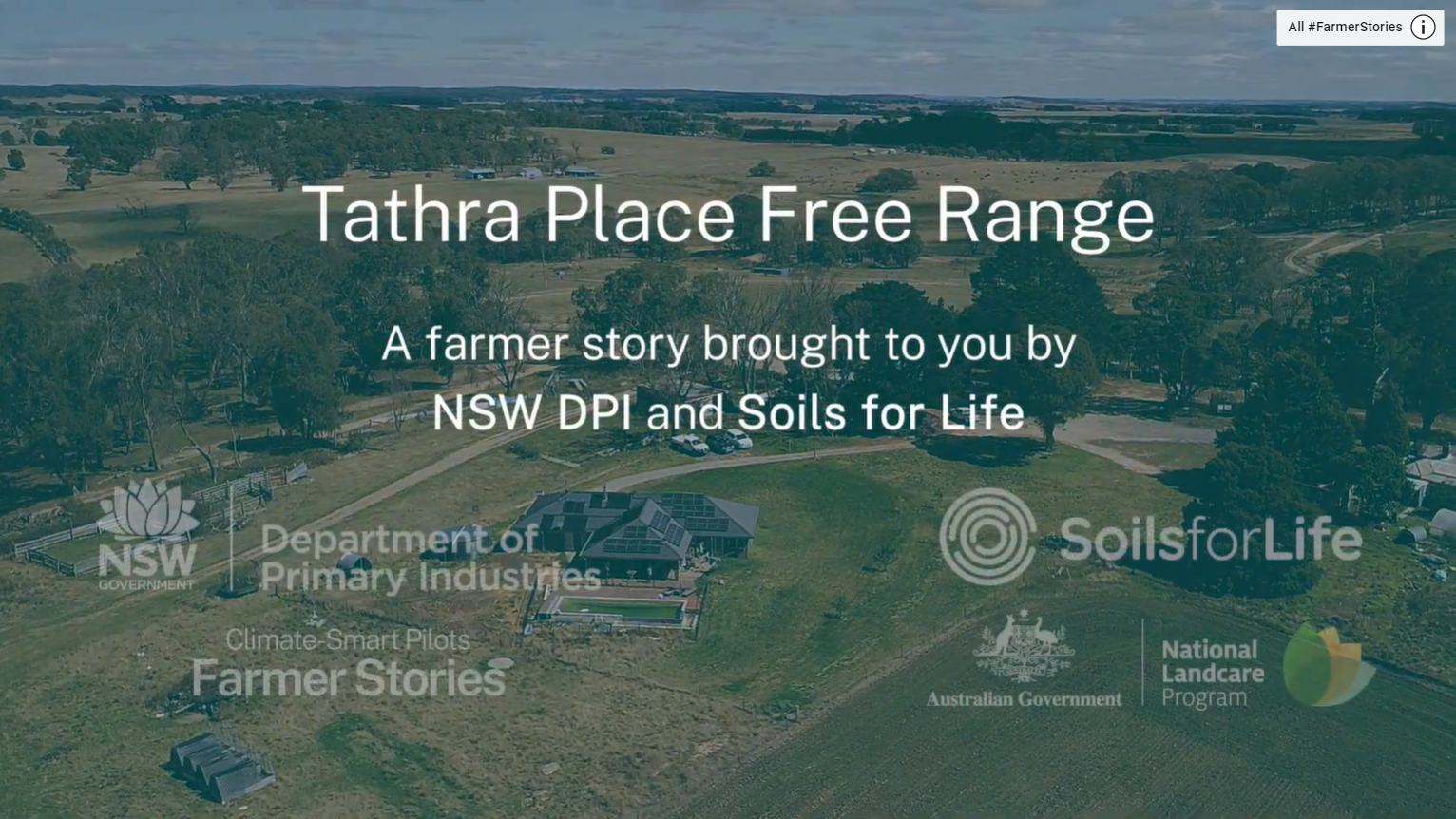"The Winders at Tathra Place Free Range"
A NEW FARMER CASE STUDY
Meet Luke and Pia Winder. From early on their goal has been to ‘feed as many human beings nutrient-dense, chemical-free, ethical, free-range, hormone- and antibiotic-free food as possible’ as a result of continually healing and strengthening the health of the soils and the landscape.
Luke and Pia Winder grew up in Sydney. They were discouraged by the existing food systems, especially some of the options for their children. Luke began to more deeply reflect on the purpose of life and what it means to live life with no regrets after caring for and losing his dad. Influenced by Joel Salatin, Luke wanted to take a chance on something he was passionate about and try to heal the landscape.
In 2015, Luke and Pia purchased a property near Taralga, NSW (about 3 hours south west of Sydney). The majority of the property was covered in blackberries which had not been sprayed with chemicals in the previous seven years and this was important to both Luke and Pia. Luke started coming out to the property a few days a week, working with pigs to clear the blackberries. Having learned about the benefits of pasture-raised chickens from Joel Salatin – such as chickens being a reliable source of nitrogen, phosphorus, potassium and microbiology for the soil – Luke invested in a few chickens and started selling eggs on Facebook.
It wasn’t long before Luke gained confidence that this could become a source of financial security, as well as being a fulfilling life path. At this point the family moved permanently to the property.
The Winders now have a thriving business using intensive rotational grazing of six animal species (cattle, sheep, pigs, quail, duck, chickens) and sell to over 40 restaurants, four wholesalers and 60 home subscriptions in the greater Sydney region.
For agriculture to transition at-scale towards practices of regenerating the landscape, Luke believes it is essential to prove that this way of farming is financially viable, including being able to start with a small budget. He also believes we need to support younger people to get into regenerative farming. In the Winders’ story, Luke shares how he, his family and team have achieved both.
Farm Facts
Location
Annual Rainfall
Agro-climatic region
Property Size
Elevation
Enterprise Type
*Learn more about soil classifications at Soil Science Australia
Farm Facts
Location
Gandangara Country | Wombeyan, NSW
Annual rainfall
840mm
Agro-climatic region
Climate Zone 7 (Cool temperate)
Property size
46ha
Elevation
949m
Social structure
Owner and operators
Enterprise type
Multi-species farming
Soils
Predominately Kurosols with a small amount Ferrosols (DPI 2021)
*Learn more about soil classifications at Soil Science Australia
Videos
The Highlights
- Intensive grazing of cattle, sheep, pigs, quail, chickens, ducks
- Growing multi-species pastures
- Chemical free
- Getting started with workers on the 88-day visa program
- Supporting young farmers though exchange of mentoring for the products of their enterprises
- Specialising in unique food (they are the only producer of Bresse chickens, one of a few producers of free-range quail, and the biggest producer of free-range duck in NSW)
- Working with top chefs and wholesalers
- Home subscriptions
- Reasonable levels of microbial respiration, organic matter, and organic carbon to organic nitrogen ratios within soils
- 4.2 – 4.8 tonnes of protein produced per week
- Luke and Pia feel their business is financially stable, employing five people
- Luke and Pia feel their business is future-proofed against increasing prices in fossil fuels, and financially stable, employing five people
- The Winders love what they do and feel their farm represents their heart and soul
- Healthy, nature-based lifestyle for their children
The Winder’s Story
- Phase 1 - Starting the farm
- Phase 2 - Rapid scaling up
- Phase 3 - Adjusting & refining the process
- Phase 4 - Now and looking ahead
Starting the farm
2015-2016
Challenging life moment
When working as an electrician in the Sutherland Shire, NSW (southern Sydney), Luke’s father developed a very aggressive brain tumour and needed a full-time carer. Luckily, Luke was able to stop working and fill that role. Sadly, because of his father’s condition, most of Luke’s days were ‘filled with listening to him share his regrets in life’. After his father passed away, Luke came out of that experience thinking about how his father was only 67, and ‘If I’ve only got 35-odd years left, I’m going to find my passion and pursue something I feel is worthwhile’.
Perspective change on food and food systems
During the quiet time when caring for his father, Luke watched many Joel Salatin videos on YouTube. Luke was very impressed with Joel’s philosophy and resulting landscape changes. Luke also watched all the Gabe Brown, Collin Seis and Darren Doughty videos he could find. These leaders prompted Luke to question his own thoughts and beliefs about soil and the food system, and this process really ‘lit something.’ Luke and Pia’s second son has special needs, which Luke and Pia began seeing as linked to diet and food production, and they started questioning what other lifestyle choices they could make.
Buying 100 acres and quickly building commitment
Inspired by Joel’s belief in the potential of a 100-acre farm, Luke began looking for property of this size near Sydney. He found land near Wombeayan Caves (about 3 hours south west from Sydney) that not only had been on the market for years – meaning that for the past 15 years of ownership, the owner had left the property alone – it had also not been sprayed. For Luke and his interest in soil health, this was a great benefit.
Even though Luke admitted to his wife that buying the property felt ‘completely insane’, they decided to jump in. As Pia reflects:
“He told me about the idea and I was like, “life’s too short to not do it”. Especially with his dad passing. What have we got to lose? I said, “Let’s find land three hours max from Sydney. So at least we can just go on the weekends.” So, we found a place and it was just a great environment for the kids.”
Initially, Luke didn’t have a vision to create a large farming business. He and his family initially thought that this land might be ‘a lovely place to get away and maybe have a few chickens’. But within a few short months, of experimenting with the eggs, Luke realised that he could make a business from this land. To say that this idea then snowballed would be ‘the greatest understatement of all time.’
“Not in my wildest dreams did I ever think I would have a farm like this. I honestly don’t know what I was thinking. I was still healing from everything that had happened with dad. But the transition between, “alright, this is a muck around, let’s go and ride motorbikes and start fires” and, “oh, hang on a minute, I think I can actually do this”, was pretty quick. It was only a few months.”
Setting a budget and making do
After committing in 2015 to ‘really make a go of it’, Luke and his wife agreed that he would begin his business with $10,000 as capital. Looking back, Luke calls this budget his ‘greatest footing to start on’ because he had to solve issues quickly and simply. This budget often meant that in the beginning Luke had to build and do a lot with the materials that he had on his property, such as using Squiggly Gum on the property to create fence posts.
Using pigs to clear the blackberries
One of Luke’s first priorities was to get control of the blackberries, which covered over half of his property, and in some places was over one-story high. Luke did not have any mechanical means to clear the blackberries, and he had already made the decision to not spray any chemicals from the outset. Inspired by Joel, Luke wanted to use animals to contribute to weed management. He experimented with goats but eventually settled on eight pigs to root up the blackberry. He went from eight to 30 Wessex Saddlebacks in that first year by retaining their females to breed his own stock.
The previous owner had only one internal fence on the property, so it was crucial to set up the fencing systems that would better suit using pigs to manage weeds. Luke used a 2-wire electrical system to build temporary paddocks for the pigs. But the pigs often got out and ‘there was a lot of swearing’. As Luke says, ‘if you want to test yourself and your character as a human being, buy 30 pigs’. He continues:
“With sheep, they will follow each other. And with ducks, they’ve got a strong herding instinct. But with pigs – five will go that way, four will go that way, three will go that way, and two will go back up where you started. It’s just a debacle. And I was trying to get them into these areas to do their work, to get rid of the blackberry, which they did. But then getting them to move with no lanes… I smile and laugh now, but, God, it’s a great way to test your patience.”
To save costs on water pipes, Luke set up this initial fencing close to the bore water source. He started with a 19 mm water pipe, gravity fed to the pen, which ended up being ‘an absolute debacle’ and has ‘since been ripped out’, but it was a simple system to get him started. To save funds, Luke also cast and poured his own water troughs for the pigs, at $45 a trough, compared to $400 for a pre-made trough.
As he didn’t have any machinery at this time, after the pigs had cleared a paddock, Luke would hand-cast a mix of seeds. He got success in regrowth, which started ‘building a little bit of confidence and appreciation of the stuff that I’m watching on YouTube’. He started believing ‘this regenerative stuff works’; the blackberries were disappearing and being replaced by ‘half-decent grasses.’
Creating a small profit in the first year
Luke bought about 200 hens to create ‘a pretty basic pasture-raised system quickly and generate income almost straight away’. To save costs, he decided to build his own basic, light ‘egg-laying pods’, which are easy to move rather than buying a mechanised chicken caravan for $22,000. Luke used the electrified feather netting to rotate the chickens and one Maremma to keep them protected. And so began the cleaning, candling and classing by hand of eggs, and selling them out of the farmhouse. Luke had ‘no worries’ finding customers after one Facebook post. These customers weren’t worried about the sizing but rather wanted ‘a dozen beautifully raised pastured eggs. These are the sort of customers that you’d need to attract when you’re starting.’
Luke began making about $900 in profit each week on the eggs and felt like he was ‘flying’. He spent $400 a week on chicken feed and sold about $1300 worth of eggs (approximately 130 dozen at $10 a dozen). Any profit went back into growing the business and improving the farm. Quickly, 200 hens turned into 1,200.
This was the point when they were sure the farm could be a profitable business, and so, in 2017, they sold the house in Sydney and moved out to the land. Pia still worked remotely for her Sydney work, while using her business background to manage the farm’s admin, invoicing, payroll and social media systems.
Building loyal customers through a farmers market
In addition to his eggs, Luke wanted to sell pork and about a dozen broilers a week. He found the Ramsgate Farmers Markets which had several strengths: it was in the Sutherland Shire in southern Sydney where he grew up, it was ‘a real foodies market’, and there weren’t limits around how many vendors could sell similar products.
Luke’s strategy for sales at the farmers market was to develop rapport with every person walking past his stall. But he also believed that having this connection to the community helped him find and create loyal customers to this day.
“Every single person there either got greeted, or handed a sample, or smiled at, or it’s amazing how easy it is to make a sale if you talk to people. And as soon as people hear that I was a local and I’d started this venture – of course they’re going to buy something. I did really well at that farmer’s market. And I made very loyal customers that are still with me. I don’t regret it for a second. Essentially, that farmer’s market built everything.”
Initial challenges in selling his pigs
Luke’s first sales of the pigs were not easy. He let his Wessex Saddlebacks, which are ‘back fatters’, fatten up too much. He was ‘in love with them, and they all had names, and were doing a wonderful job on the environment’ but he kept them too long. Which meant they were harder to sell initially as they were just ‘too fatty’. Even though ‘an educated consumer appreciates that you want to eat that really lovely pasture-raised animal that’s been out in the sun and it’s had tons of vitamin D and the oleic acids and the Omega-3s – the profile in that fat is phenomenal – you don’t want two inches of it.’
Employing 88-day visa workers in the second year
One of the first actions Luke undertook in 2016, his second year of running the farm, was to find staff on the 88-day visa program. Luke often had up to 400 people apply, so family friends, with experience in recruitment, taught Luke how to ‘look for a good staff fit’. He found a lot of success with couples, as they were able to ‘amuse themselves’ in the rural area together on their days off, but also because he thinks gender balance is important. Also, oftentimes, he found ‘the women were much better workers, even physically, than the guys.’
Luke describes the three stages of the three-month worker: the first month ‘they’re training and probably a detriment, the middle month they’re probably a slight benefit to the business, but that last month, they’re phenomenal.’ Because the first month of training was such an investment of his time and energy, it was also important for Luke to quickly learn to say, ‘no, this isn’t go-to work.’
Luke and Pia really valued this program. They would pay above award, provide accommodation, internet, alcohol, and meals but they would ‘expect a lot in return’. The staff focused on creating larger cells, or paddocks, often clearing, drilling or fencing the paddocks. Recognising ‘we owe a lot to them’, to this day, Luke’s paddocks are named after their 88-day visa workers.
Trials of rotating three species
Having the extra ‘manpower’ of the visa workers for building fences ‘was huge’. This allowed Luke to focus on management of the intensive cell grazing and replanting on a larger scale. He was able to jump from 30 pigs to 250 pigs, and incorporate cattle into the grazing. After paddocks recovered from the pig disturbance and grew back with seeding, Luke used temporary single wire to move the cows about every two days, which were closely followed by the chickens. With the cycling of these three species, Luke started to see more growth and more varied species in the pasture, with Phalaris, cocksfoot and fescues pastures growing.
Rapid scaling up
2017 – 2019
During this period, Luke won a Delicious Award, what ‘was a giant shot in the arm’ and important in his process of scaling up. Luke also identified other aspects helpful to his scaling up, including: transitioning to ducks, lamb and French Bresse chickens, and finding other avenues to sell his meat, such as direct to restaurants, distributors and wholesalers.
Transition from broilers to ducks
Broilers, Luke learned, weren’t good for his climate, and pastured eggs at scale weren’t paying off, so he stopped. Luckily about the same time in 2017, a loyal customer asked Luke for free-range duck, which was ‘impossible to find’ at the time.
Luke started the ducks in the paddock ‘Chamie’ that had bare patches and clearly ‘needed fertility’. He initially used feather netting to move the 200-odd ducks in 150 square meter cells over this eight-acre paddock. In his opinion, of the six animal species Luke’s been working with so far, ducks ‘are by far and away, the best fertility’, and felt his initial grazing density was ‘the perfect amount’ of fertility for this paddock.’
Luke found that ducks love the cold, wet weather of the local climate, so he kept cycling ducks through ‘Chamie’, reaching around 50,000 ducks over the course of about one year. But Luke wanted more diversity in his paddock plants. He let the pigs disturb the soil and add their own fertiliser, and then Luke direct drilled a mixed species. The next season, the paddock ‘went bonkers, completely off its head last spring.’ He had a thick undergrowth of clovers and legumes, and the rye, cocksfoot and Phalaris ‘shot straight up’. This ‘great result’ was a ‘confidence booster’.
Outgrowing the farmer’s market
Luke passionately acknowledges that the farmers market ‘played a really important role’ in developing his business, but eventually, Luke got to the point where his business outgrew the markets. Farmers, Luke insists, should pay themselves an hourly rate; and the time it took Luke to prepare for and attend the outdoor markets – the success of which was dependent on the weather – couldn’t compare to his ability to make ‘two phone calls’ to chefs and ‘sell all the product now instead of standing around for eight hours in the rain.’
Expanding avenues for selling meat
And so, in this period, Luke expanded his business to food service, which had the potential to be more profitable if he could sell the whole body of the pig. He found that when chefs are doing their costing, ‘such a small amount goes into each dish, that they can afford to pay a bit more’ for the providence and the story of the pork raised at Tathra. Even so, it is challenging to sell the whole body as ‘the skill set of breaking down pig within the food service industry is disappearing.’ He remembers thinking, ‘Oh my God, I hope I can sell all these things.’ But, soon, his pigs had ‘the reputation’ and he had ‘no problems’ selling his pork. He would drop them at the abattoir, and then pay a meat cutter to drop the animal anywhere in Sydney. He effectively outsources the logistics but does all of the sales and marketing.
Ducks are a ‘hard product to sell to retail’, but Luke realised ‘pretty quickly’ that ducks are ‘really, really popular amongst chefs’. Hence, Luke ‘started making extra effort’ to reach out to the best chefs across Sydney. He believed that developing meaningful relationships would be essential, so he invited the chefs and their family out to the farm. ‘They’ve stayed with me, we’ve had beers around the bonfire.’ There is now the personal connection with each of these chefs:
“When they look at that duck in that bag, they see my face and they see my family and they see my kids and they understand the operation. When Quay or when Bennelong are redoing their menu, it’s not, “Oh, are we going to use duck?” It’s, “What are we going to do with Lukey’s duck?” See the difference there? We’ve been the anchor on the degustation at Quay for five years. Five years – that doesn’t happen. If I can get a chef to come here, they will buy produce off me until the day they stop being a chef.”
Luke also reached out to other respected distributors, such as Emilio’s and Feather and Bone. All of these distributors grew into long-term, consistent customers and ‘great payers’. For example, he drops the animals at the abattoir on a Monday and gets paid on a Tuesday, even though Feather and Bone don’t get the meat until the Wednesday, and ‘that’s what you want, right?’.
A game changer - finding a wholesaler
With the increasing types and volume of produce – with an average of 1200 kilograms a week – Luke decided to find a wholesaler. He was grateful to meet Game Farm Australia, which became a relationship that grew into a trusted partnership.
Game Farm Australia helped Luke scale the ducks from 50 a week to a 1,000 a week. The duck enterprise ‘made my wallet a lot fatter, and I was reinvesting every single cent that I was making’. The ducks still make up the ‘lion share’ of the financial benefit, which ‘opens a lot of doors’. Tathra Place are the biggest producer of free-range ducks in NSW, so Luke feels ‘lucky to fall into that.’
Looking back, Luke thinks that the day they decided to use Game Farm Australia was ‘probably, single-handedly, the best business decision’ he has made:
“I don’t think I’d be able to offer fresh product weekly to local systems without Game Farm and the logistics that they’ve got. They’ve got trucks going through to Sydney every day. I think it’s been amazing for me. And yes, we do have to offer them a wholesale price and yes, they put a percentage on that, but they’re worth every cent for what they’re providing. So, if you have to sell your chickens for three bucks less a kilo, but it allows you to be on farm and grow another 500 chickens a week, you’re in front.
I mean, the overwhelming mantra of the business I’m trying to set up here is feed Australians chemical-free, nutrient-dense food. Game Farm has allowed me to feed a lot more Australians chemical free, nutrient dense food, because I’m out here focusing on growing ducks, not driving around, delivering them.
And there are bad wholesalers but if you can find people like Game Farm, who are still to this day, producers, and understand the complications and challenges around being a producer, and they have understanding around that, and work with you and do a lot of phenomenal stuff for you, I mean, what a massive win.”
Requests for lamb
The chefs that Luke developed relationships with began asking him to produce lamb. The chefs were ‘sceptical of the industry and their chemical-free and antibiotic-free claims’, but they trusted Luke to deliver on these claims. Luke started with crossbreds, but really disliked the crutching and shearing, so he moved on to the Aussie whites, which he found robust and ‘just phenomenal.’ He has not yet had one sick Aussie white.
Growing reputation which attracts opportunities in French Bresse
Arguably because of Tathra Place’s reputation and online social media presence, Luke was sought out to take part in an enterprise of Bresse chickens, a meat bird imported from France. As the Bresse enterprise was in its infancy in Australia, the investor needed someone to grow the birds. Despite the many hurdles of ‘plucking a bird out of another country and trying to slot it into Australia’, they have now found success, both in breeding and sales. Tathra Farm uses another ‘really amazing wholesaler’, Two Providores, who are ‘really passionate about the product’, and Luke trusts them to find the right buyers for this niche product. Being ‘the only person in Australia to have the genetics, you can be ‘really clever in who gets it’. For example, when Luke:
“really found success with my ducks, it’s because Peter Gilmore[1] started using it, and guess what happened? Every chef in Australia wanted it, right? So, we are trying to be strategic as to where the Bresse goes.”
Incremental upgrades of equipment
Luke attributes the incremental upgrade of equipment – such as food silos, duck modules, skid steers and loading facilities – with their continual scaling up. After struggling with bulk bags, Luke invested in silos in 2019. They could now buy 40 tons, as opposed to one ton, of food which resulted in ‘massive savings.’ Luke also invested in duck modules that same year to improve their loading into trucks. These modules weigh 1.2 tons when full with ducks, so he invested in a $45,000 skid-steer to lift the modules. With ‘many trial and errors’, Luke landed on a loading facility that works with his animals’ nature. He now has a ramp with a slight gradient that the ‘pigs will walk through peacefully’. All these improvements help streamline the work and enable the growth of Tathra Place.
Adjusting and refining the process
2020 - 2021
With the arrival of COVID-19, Luke and Pia had to rethink quite a few aspects of their business, including the 88-day visa employment and restaurant sales.
Pivoting in COVID to long-term employment and home subscription sales
When Luke was no longer able to employ people on the 88-day visa program, he had to pivot to long-term employment. He’s since hired a chef interested in regenerative agriculture as a farm manager. The manager has been learning from Luke while on the job, and Luke is keen to retain him, so they’ve started a Speckle Park beef company together, which Luke hopes will give his manager the incentive to stay.
Shifting to food service was working really well, until the pandemic hit, and ‘every single restaurant shut.’ So, Luke had to shapeshift again into offering home-delivery subscription services. His years at the farmers market paid off, as ‘99% of what I am now calling my home subscription service is just my market customers.’ Most of his beef goes through the home subscriptions.
Including quails
Game Farm Australia ‘saw the potential and appreciated how unique’ Luke’s system was and decided in 2020 to work with Luke to create their pasture-raised quail operations. Luke built a Joel Salatin-style moveable quails sheds, with standing room. Every week he takes 250 quails to the abattoir, and Game Farm ‘handles the rest from there’.
Permanent fencing
For several reasons, Luke decided to install more permanent fencing. For a while, Luke was using electric fences to constrain the animals, but his pasture regrowth kept grounding the electric current, thus allowing ‘the pigs to walk straight through’. Because Luke does not use chemicals to prevent growth around fence lines, he either needed ‘a full-time worker whipper snipping the fence lines to stop the earthing of the electrical fence’ or a different solution.
In addition, Luke also ‘hated everything about temporary fencing,’ including their weight and time required to move them, as well as setting up different systems for animal groups. So, when the money was available, Luke invested in permanent fencing in 2021. This new fencing works for all of his animals: quail, chicken, duck, pig, sheep and cattle. Recognising that some operations benefit from temporary fencing, for Luke, the time saving as a result of the permanent fencing has been ‘enormous’, and he considers the investment a success.
Luke has learned that the ideal grazing cell for him is on average one acre. The primary reason for this size is the ducks. Firstly, it is not possible to rotate the ducks during their life because ‘they don’t walk well’. Hence, the ducks stay in the same cell for their five-week growing period. They go from the brooder, to the cell, to the truck to be processed. The next flock of ducks are put in a new cell. Luke originally had half acre cells, but for 1,000 ducks, ‘it was just disgusting by the time the ducks had finished’. He found the one-acre cell can handle the fertility of 1,000 ducks over the five-week growing period.
Another benefit of the one-acre cell size is that it easily lends itself to experiments. You can ‘muck around with, “Hey, I’ll just drill some rye and cox foot into this one and see what happens” and it doesn’t cost you much. It’s a great little test case’.
Even with all of these animals rotating across Tathra Place, the cell size means that each paddock rests for about 90% of the time, giving the pasture ‘the time to repair, grow and get into that proper pasture growth cycle where it is really photosynthesizing and doing all those wonderful things.’
Now and looking ahead
2022
Continuing to realise the vision for their farm
Luke’s primary vision for his farm is to ‘heal this piece of land’ and ‘leave it better than what I found it’. His farming system ‘copies nature’ by enabling interactions between diverse pasture and animal species. These interactions speed up the process of improving top soils and carbon sequestration.
The ‘quail, duck, chicken, pork, beef, lamb that gets turned off this place for my customers to enjoy, and for their bodies to be fuelled by all the nutrients and benefits that come with that, is a by-product’ of his goal to heal the land:
“The tools I’m using to heal the land are these amazing pieces of infrastructure called animals that we then get the absolute honour and privilege to process and consume. What an honour.”
Luke’s other goal is to ‘feed as many people nutrient-dense, chemical-free food as we can’. He is proud of what they’ve achieved by currently servicing ‘well over 40 restaurants, four or five butchers, and about 60 home-subscriptions; then Feather and Bone’s an outlet, Game Farm’s an outlet; there’s quail going to Tasmania at the moment.’
Constantly learning from the rotations of his stock
Seven years down the road, Luke feels his system is now working ‘pretty effectively.’ Luke believes each of the animals offers their own type of fertility and their own microbial communities to exchange with, and improve, soil microbial communities. Luke believes each animal also has its own strength – ducks offer the best fertility, quail scratch in the duck droppings, pigs both disturb or graze, and cattle stimulate grass growth (Table 1). In distinguishing between the cattle and the lambs as ruminants, Luke uses sheep for grazing pasture in preparation for cropping:
“The sheep will graze a pasture down to bare soil, which if you want to do some pasture cropping, is priceless. They create very little compaction because they’re not a heavy animal. And then you can drill that. And the most exciting thing about sheep is you can then give the pasture six or seven days, and just before that seed’s about to germinate, you can graze it again. Because the sheep don’t eat any of the seeds. So even if there is a little bit of perennial regrowth that would compete with whatever you’ve drilled, the sheep will slam it again. Then you pull the sheep out. With management alone, these guys are getting equivalent results of spraying glyphosate, plowing, fertilizing. It’s just so effective.”
Essentially, Luke is ‘managing this place so that it has the biggest amount of biomass, can carry the most amount of animals, and be financially amazing.’ Instead of having a firm rotation plan in place, Luke uses his ‘grazier’s eye’ – a term he attributes to Joel Salatin – to manage his land. Depending on the season, pasture mixes and his need, Luke decides whether the paddock might benefit from certain types of fertility or disturbance. While there is no grazing formula for achieving this, Luke has basic guidelines for transiting the animals around the paddocks (Table 1).
Table 1. Number, source, benefit and grazing pattern of animals on Tathra Place Free Range
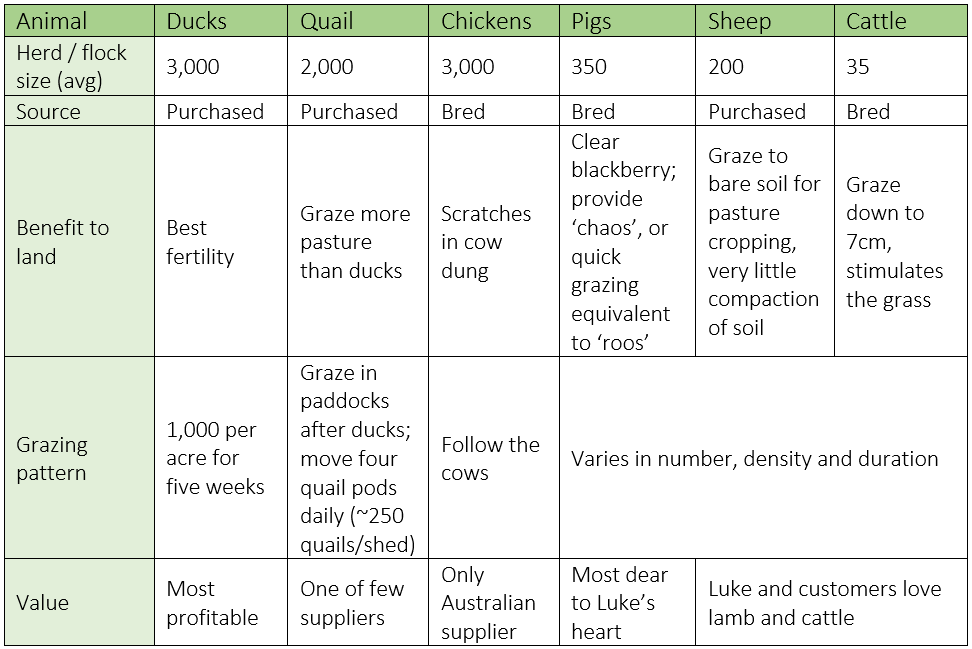
Long-term planning for developing and refining paddocks
About half of Tathra Place has permanent paddocks, and Luke is continuing to build more. The masterplan of the farm layout (Figure 2) can be described as:
- A ‘spine’ of the main lane system, which runs along a ridge
- Branches of lanes off the main spine, which run down valleys
- About 45 cells, roughly one acre, are permanently fenced on either side of the branching laneways.
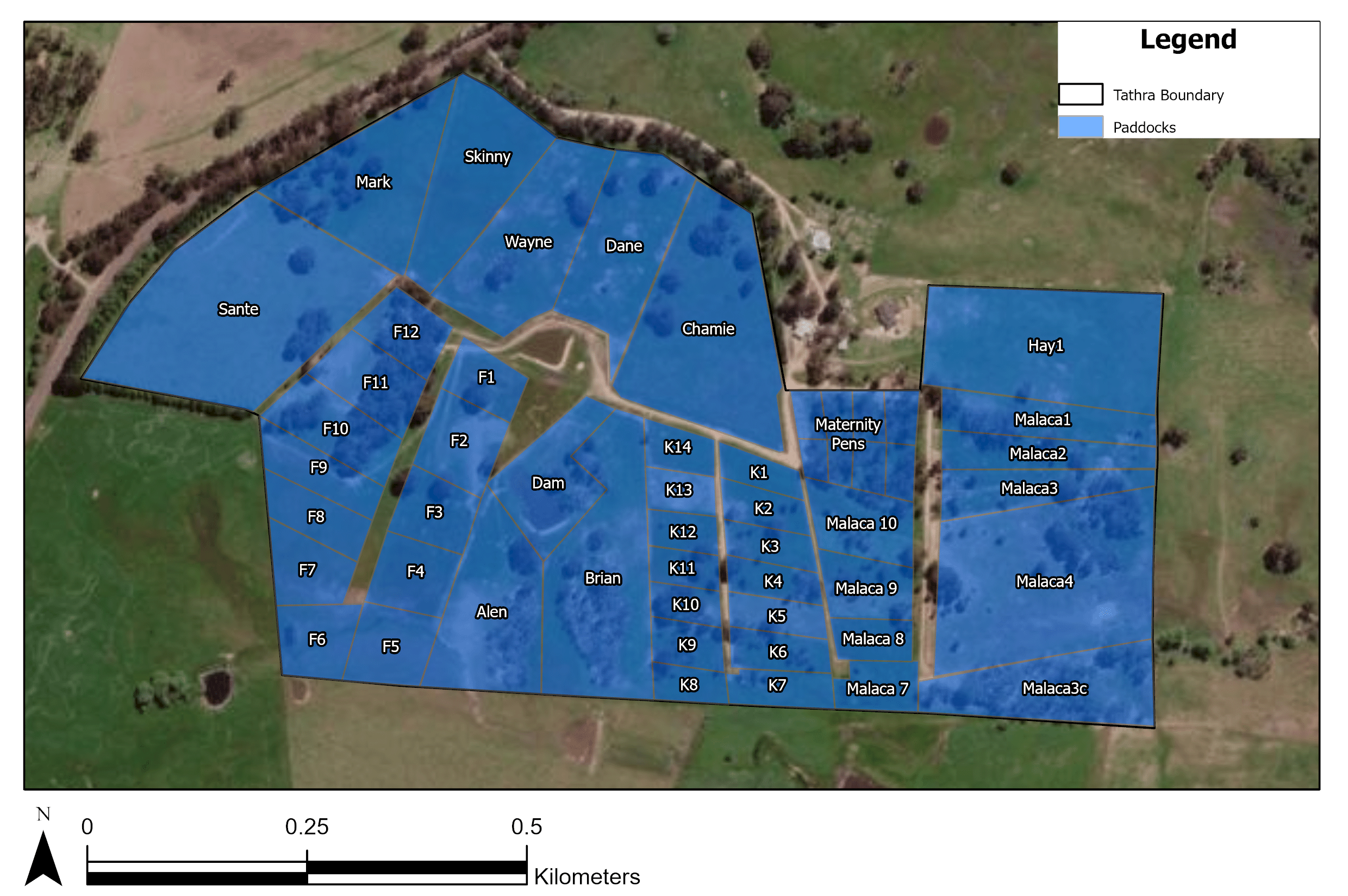
Figure 2. Tathra paddocks, as currently allocated, in 2022 (Source: Soils for Life).
To guide the creation of additional paddocks, Luke will use insights from farm designers like Australian Darren Doherty[1] to consider the direction of water (and hence, nutrient flow) in the creation of new paddocks. He also has a long-term vision for tree lines being integrated between his cells.
[1] More information on Darren Doherty can be found here: http://www.regrarians.org
Developing a new property and growing the pig rearing
Luke has recently bought another 150-acre property, in which he plans to use an identical paddock design. On this property, he will grow his Speckled Park cattle business with his farm manager, but for several reasons he wants to dedicate the property primarily to pigs. Firstly, pigs are more land intensive than the other animals he works with. Secondly, his vision is to transform Australia’s pig industry, an issue close to his heart:
“The way that swine is treated in that country is a giant thorn in my side. I think the way that we treat pigs in this country is an absolute insult to every Australian that’s consumed bacon, pork, salami, or any pork products. If they understood the intellect and the compassion that this animal has – similar IQ to a dolphin – and the way we treat them, you’d never buy a pork product. And what’s even scarier is the amount that we import…In my heart of hearts, that’s the thing I’m most passionate about. And I see my role as being a mid-tier pork producer. So, once I get over that 100 sales, that’ll actually allow me to bring my price down. And then flood the market with really good pork, especially in Sydney. I want to prove the concept of woodland, silvopasture pork.”
Luke hopes to have 100 swine by the end of next year (2023) to put him in a ‘good position’ with the new property. Right now, Luke believes it is not financially viable to produce pasture-raised pork as a single enterprise. He knows of six ethical pork producers who have gone out of business during the lockdown and finds it ‘heart-breaking’. He is investing in the pork enterprise from his other enterprises, as he ‘honestly feels it’s the right thing to do.’ He wants to be able to say, ‘You can buy Australian grown, free-range, chemical-free, ethically-raised pork’ to as many consumers as possible. Yet, he is also trying to expand rapidly with pigs, because the ‘appetite for ethically-raised pork is way higher than it was five years ago’ and there is a ‘huge market’ for it now.
Supporting young people
Luke admits he’s learned ‘a truckload’ off YouTube. He believes that in this ‘great era of self-learning’, if you want to learn something new, ‘you are limited by your input, effort and work ethic; you can learn anything’. An important part of this journey for him has also been learning from his mistakes. He is very honest about how ‘it’s been mistake after mistake’:
“Down the back where no one can see, I have a walk of shame, which is all the stuff that I’ve built that was an absolute nightmare. That original chicken tractor I built is down there. It’s quite a museum piece. You can walk through and see all the nightmare efforts that they’ve been. And you can sort of see where I’ve transitioned from – Joel Salatin builds everything out of untreated timber, oh God, I couldn’t advise against that more – to learning how to weld, build with steel, which just last forever.”
Luke is also very upfront about how hard this work really is. On a daily basis, he is ‘servicing skid steers, and then rebuilding engines, and then I’m welding, and then I’m still a licensed electrician, and then I’m burying pipe and doing roof plumbing; and then I’m in, having conference calls with some of the leading chefs in Australia.’ He admits he has a unique skill set, that helps him thrive in this space.
Based on everything he has learned, he feels a ‘responsibility on me now to share the knowledge I’ve got’. He gives farm tours, has a YouTube channel,[1] mentors young farmers working for him, and he plans on having a formal intern program in the next ten years of his journey.
Luke recognises that many people have the ‘urge to be in agriculture, but unfortunately the obstacle of access to land is a full stop for them.’ So Luke is ‘trying to give people that opportunity.’ He currently has five young farmers living and working on his property, and each of the arrangements with his younger mentees are unique according to their goals. For example, Sam did an internship in market gardening, but is not in a position to take on market prices to lease any property, so Luke ‘leases him the land for a dollar a year’ and provides accommodation, marketing mentorship and access to contacts and restaurants, in exchange for Sam to feed the Winders ‘incredible spray-free, year-round vegetables.’ This non-financial exchange is a ‘relationship that works really well.’
One piece of advice that Luke tells younger farmers it to make sure farming is something that you are absolutely passionate about and if you are, then, ‘go for it’. He continues:
“If it’s your passion and your drive, you’ll succeed because you will go to the ends of the earth to succeed. That’s what I’m like. I’ve had every hurdle. Financially there’s been no investment here. I’ve had wholesalers try and screw me, staffing issues, predator issues, weather issues. Prepare yourself just to have euphoric highs followed by soul crushing defeats; animals that you love dying in your arms.”
He also tells young farmers that they have to be resilient:
“I often say that the greatest skill you need in region ag is resilience. You are going to cry often. You are going to laugh very often, but you just get beaten down daily. Daily. A fox gets in and just decides to have a ball and kill 100 ducks. How do you respond to that? Every moral, standard and ethic that you think you hold is about to get tested.”
[1] Tathra Place Free Range YouTube channel: https://www.youtube.com/channel/UCg__ubQBxMWroN1CjeCcKBQ
Succession planning
Luke and Pia make their farm decisions with their kids in mind: ‘everything we’re doing is for the kids, our three boys’, Pia says. Both Pia and Luke would love for the boys to grow up and take on farm and its principles as their own. In fact, part of ‘tightening our belt and buying the additional land up the road’ is to build for a future with the boys and their families.
However, even while they are hoping one of the boys will ‘continue the legacy’ and for the farm to ‘be generational’, Luke is also very vocal that there is ‘no pressure’ for the boys to take over the farm, ‘just because I went mad and decided I wanted to be a farmer’. Rather, ‘hopefully the real lesson they’re getting from me is that I found my passion and I pursued it with everything I had. So, I hope they do that, not just do this because I was doing it.’
In the meantime, Pia hopes that that farm will ‘get to a point where Luke can step back and focus on things he needs to and have other people run the place.’ ‘I knew she was going to say that’, quips Luke.
Soil stewarding
Luke’s long-term goal is to work towards a soil food web[1] that is diverse and functional enough to support more and more perennial systems. Luke can work towards this goal by bringing in multi-family seed mixes to lift the food web diversity and resilience over time. Luke has many tools to keep building the functionality of his soil, in terms of his diverse animals, observation skills of the landscape, ability to plant diverse family groups, and ability to maintain near constant ground cover. His diverse animals (quails, chickens, ducks, pigs, sheep, cattle) each bring unique organic nutrients (e.g. nitrogen from the fowl) and microbiomes (in their breathe, dung, urine and saliva) to the soil. In addition, the diversity of animals can be used to respond to the unique needs of the landscape.
Luke is keen to focus on his role as soil steward. He brought on new staff so he has time to undertake more measures to improve the functionality and resilience of his soil/plant/animal systems, as well as observe and record the influences of the changes to his practice.
Simple soil monitoring includes shovel tests; observations of plants, root and nodules growth; water infiltration, and Brix meter.
“This is the role of structured for myself now anyway, this is why I’ve just taken another staff member. This is what I should be focusing on, not fumbling around fixing fences and worrying about whatever else. This [looking after the soil functionality] is what I want to be doing.”
[1] For more information on the soil food web, see the Australian Soil FoodWeb Institute: https://soilfoodweb.com.au/
Working Towards Holistic Outcomes
Find out more about the practical and scientific information around the outcomes to which the Winder family at Tathra Place Free Range are working towards.
In this section, we present the changes that Luke is working towards and has observed over time in relation to soil, financial and social outcomes of their farming philosophy and practices.
SOIL
Changes in soil
Healthy soils require a healthy soil food web. The soil food web at Tathra Place is reasonable in size. High levels of microbial respiration indicated good levels of soil food web activity for the current community’s size, though the potential growth of the microbial community is still great.
Healthy soil food webs require access to air, food, water and housing. In regards to air, Luke’s calcium-magnesium ratios (an indication of aeration) are giving marginal to adequate aeration potential to his soils. Regarding food, the ratio of organic carbon to organic nitrogen provides an indication on the quantity and quality of food for microbes.
As such, organic carbon and organic nitrogen are both required to help achieve the optimal function of the soil system and are intimately tied together. Ideally, there are between eight to fifteen carbon for every nitrogen. All of Luke’s soil samples were within this range, indicating a good balance of available energy and nitrogen for microbes. These organic content levels also indicated sufficient housing availability. Visual observations showed sufficient water infiltration into the soil.
These levels of sufficient air, food, housing and water infiltration in Tathra’s soils are influenced by Luke’s practices of growing diverse plants for the majority of the year. By growing and encouraging balanced multispecies mixes, future management will continue to encourage the balanced growth of carbon and nitrogen together to maximise biological processes.
The higher order communities of Tathra Place’s soil food web could be supported more. His fungal communities were present in small numbers but inactive at the time of sampling. To wake up his fungal communities, Luke could plant species that are highly mycorrhizal, such as oats, cereal rye corn, linseed or Phacelia.
While Luke has seen earthworms re-appear due to his landscape management practices, the soil tests showed low levels of smaller nematodes. These smaller nematodes are essential to the functionality of the nutrient delivery system, with well-known nutrients being phosphorus, calcium and zinc.
One of the simplest ways to lift the complexity of the entire soil food web system is to increase the diversity of all the inputs, for example:
- the number of plant families in seed mixes
- the variety of bio-stimulants, either as seed dressings or as foliar
- the creation of variable canopy heights and leaf structures in plant selection.
For example, Luke could ensure there are at least four distinct plant families represented in his seed mixes as each family offers a unique service to the soil and landscape functioning. This diversity of species also stimulates different microbial communities below ground. Of benefit for Luke are his smaller single acre cells. He could trial various seed mixes (which is not a big initial cost) and experiment with seed that is harder to get in volume.
ECONOMIC
Economic changes
The six-year analysis shows that profit was negative for the first four years, during the establishment phase due to substantial business and farm development costs. However, in the most recent two years, profits have been generated (Figure 4).
In line with a trend of increasing profit, the turnover of the business has grown substantially and almost doubled in the last two years (Figure 5). Importantly, the gap between trading (gross) income and expenses is also widening over time.
These turnover trends have mainly been driven by the new duck enterprise in 2021 and show the potential that exists in a small and intensive farm, when enterprises are stacked in a synergistic manner.
In sum, this case study shows a stable and successful family living can be gained from a very small farm area, if approached with a business mindset which is focussed on regeneration, diversity, high value and intensification.
While Luke is experiencing an increase in profit, turnover and net asset value, he still sees a need for consumer education to support the viability of regenerative agriculture, in terms of valuing the quality of produce with soil health in mind
SOCIAL
Social changes
The biggest change for the Winders has been a lifestyle change. For the kids, the change has created the conditions for their children to value hard work, contribute to the family, be responsible, and generally, ‘be good at life’.
Another social change for Luke and Pia, is that they now feel they are contributing to a bigger purpose, rather than ‘just working in a job’. Important to them, this bigger purpose found in the farm feels like a family affair. ‘We are all together, Mickey [their eldest son] holds the board, and Johnny’s [their youngest son] in there helping.’ The Winders ‘love doing’ what they do.
Relationship to farming
As shown in Figure 7, Luke’s relationship to farming has steadily improved from Phase 1 (2015-16) to today (Phase 4). This increase in Luke’s responses during each phase presumably reflects his improving confidence as he gained experienced in running the farm. Luke’s optimism for the future was high and constant during his farming journey.
Figure 7. Luke’s responses to questions about his relationship to farming, from the start (Phase 1) to now (Phase 4).
Personal wellbeing
Overall, for Luke, five aspects of personal wellbeing have increased since he began farming in 2015 (Figure 8), including his health, his satisfaction with life as a whole, his sense of life achievements and his feelings of security about the future.
Luke felt his standard of living dropped during Phase 1 to 3 (2015-2021). For Phase 1 (2015-16) and Phase 2 (2017-19), Luke’s perception of a decrease in his standard of living may be a reflection of the challenges of starting an entirely new business and life direction from scratch, and the COVID-19 pandemic may have impacted Luke’s sense of standard of living during 2020-2021. However, in Phase 4, his perception of standard of living increased to its highest level of the four phases.
Luke has always been ‘extremely satisfied’ with his personal relationships and feelings of being safe throughout his farming journey. Interestingly, Luke’s has been consistently ‘satisfied’ with his feelings of community connection during the last seven years of farming. According to Luke and Pia, one of the biggest contributions to personal wellbeing in regenerative farming is the connection to their customers, and the feedback and appreciation this enables.
Figure 8. Luke’s responses to personal wellbeing questions, from his early days (Phase 1) to now (Phase 4).
Full Reports
Podcast Episodes
External Links
Do you have any questions or feedback regarding our case study reports?
We’d love to know more about your profession, location, and reason for accessing the report. Get in touch, we’re happy to help.
This project is supported by the Australian Government’s Smart Farms Program.




